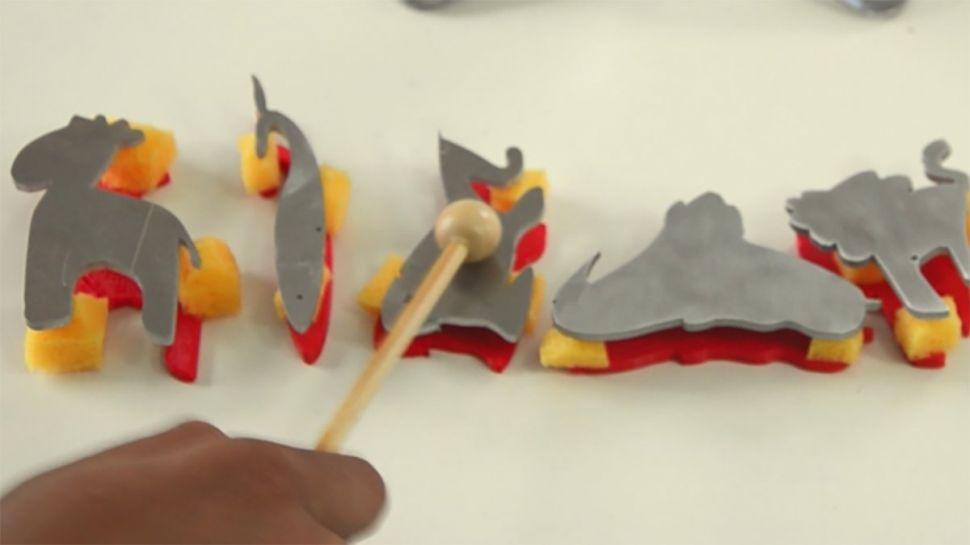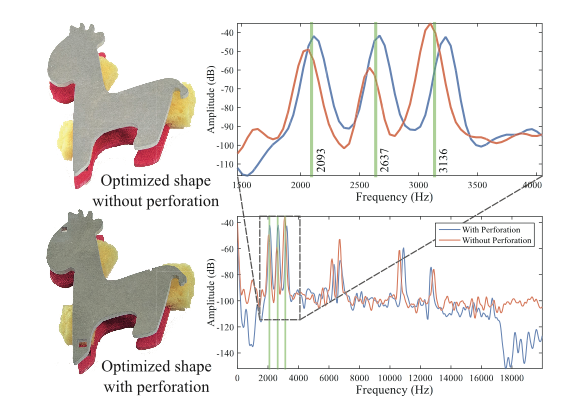I am a university professor, and I have been guilty of this myself. Taking a subject which is actually a great deal of fun to explore and then, in the best academic traditions available, making it nearly impenetrable to the average reader. It’s not so much a conscious effort to obfuscate, but rather because as academics, this is part of the way that we think. It’s not a ‘spade,’ it’s a ‘manual earth restructuring implement’ and that really means something to us. If you can get past the writing, which is probably clear as a bell to others in their field, an article scheduled for publication in the journal of the Association for Computing Machinery, Transactions on Graphics (ACM TOG), entitled “Computation Design of Metallophone Contact Sounds,” is actually quite entertaining.
 For this article, a team of researchers worked on tackling the problem of reverse engineering the form of a metallic musical instrument based on a starting shape and a particular desired sound. The instruments they worked to create are members of the Matallophone family which include other venerable relatives such as the glockenspiel. The key here is that glockenspiels and other instruments like it are actually extremely complicated to create. Not only does their form have to be exact, dimpling and other slight deformations are necessary to precisely tune each note to be produced…thus rendering the home-glockenspiel industry nearly unheard of.
For this article, a team of researchers worked on tackling the problem of reverse engineering the form of a metallic musical instrument based on a starting shape and a particular desired sound. The instruments they worked to create are members of the Matallophone family which include other venerable relatives such as the glockenspiel. The key here is that glockenspiels and other instruments like it are actually extremely complicated to create. Not only does their form have to be exact, dimpling and other slight deformations are necessary to precisely tune each note to be produced…thus rendering the home-glockenspiel industry nearly unheard of.
The authors here–coming together from Harvard, Disney Research, Columbia, and MIT–have attempted to devise an automated method by which an initial shape and information about the pitch and strength of the note to be produced can create a 3D model of the form necessary for its creation. That model can then be sent to a 3D printer or other advanced fabrication system and faster than you can say “user-supplied frequency and amplitude spectra” the metallophone of your dreams is being created.
 Not to be accused of being humorless, the research team took the shapes of a variety of animals and worked them through the mathematical modeling algorithm they developed in order to develop their instruments. The algorithm determines desirable placement of the mass and location of perforations that effectively tune the form to produce the desired sound at an appropriate volume, then 3D prints it. My favorite metallophone is the giraffe, but they have also 3D printed instruments shaped as a whale, elephant, lion, and an anteater, each of which produces its own note. A special moment of excitement comes when the team realized that it had produced a giraffe-shaped instrument that could produce a chord when struck, possibly making it the first multi-tonal glockenspiel key ever produced.
Not to be accused of being humorless, the research team took the shapes of a variety of animals and worked them through the mathematical modeling algorithm they developed in order to develop their instruments. The algorithm determines desirable placement of the mass and location of perforations that effectively tune the form to produce the desired sound at an appropriate volume, then 3D prints it. My favorite metallophone is the giraffe, but they have also 3D printed instruments shaped as a whale, elephant, lion, and an anteater, each of which produces its own note. A special moment of excitement comes when the team realized that it had produced a giraffe-shaped instrument that could produce a chord when struck, possibly making it the first multi-tonal glockenspiel key ever produced.
“Our discovery could lead to a wealth of possibilities that go well beyond musical instruments. Our algorithm could lead to ways to build less noisy computer fans, bridges that don’t amplify vibrations under stress, and advance the construction of micro-electro-mechanical resonators whose vibration modes are of great importance,” said research team leader Changxi Zheng, assistant professor of computer science at Columbia Engineering.
 Part of the process of tuning the form also came in deforming the original outlines. It’s not as easy as using a cookie cutter to replicate the shape of a giraffe. The algorithm that the researchers created also pushes and pulls the shape, within boundaries, in order to optimize the sound. The modified shapes are highly stylized versions of fairly primary representations of the animals and are actually quite interesting in and of themselves, resulting in a much more dynamic set of graphics than originally created. The relationship between visual and auditory is one in which both become more interesting as the result of the other.
Part of the process of tuning the form also came in deforming the original outlines. It’s not as easy as using a cookie cutter to replicate the shape of a giraffe. The algorithm that the researchers created also pushes and pulls the shape, within boundaries, in order to optimize the sound. The modified shapes are highly stylized versions of fairly primary representations of the animals and are actually quite interesting in and of themselves, resulting in a much more dynamic set of graphics than originally created. The relationship between visual and auditory is one in which both become more interesting as the result of the other.
“By automatically optimizing the shape of 2D and 3D objects through deformation and perforation, we were able to produce such professional sounds that our technique will enable even novices to design metallophones with unique sound and appearance,” said Zheng.
The final bit of fun comes in the name the researchers have assigned to the newly created fauna-based instrument: The Zoolophone. It’s a play on the more traditional xylophone, an instrument with wooden keys and so not actually the most direct relative of what they have created…but it’s a heck of a lot cuter than any of the other names that were more accurate, and so I think it can be forgiven.
After all, you’ve got to let a little fun get through now and then.
Let us know your thoughts on these cute little instruments. Discuss in 3D Printed Metallophone Instruments Forum thread on 3DPB.com.
Subscribe to Our Email Newsletter
Stay up-to-date on all the latest news from the 3D printing industry and receive information and offers from third party vendors.
You May Also Like
IperionX Inks 10-Year Deal with Wisconsin Manufacturer for 80 Metric Tons of Titanium Per Year
IperionX, the Charlotte-based supplier of sustainable titanium powders used for additive manufacturing (AM) and metal injection molding (MIM), has signed a ten-year deal with United Stars, a group of industrial...
Gastronology Launches Industrial Production of 3D Printed Food for Dysphagia Patients
Food 3D printing has, in many ways, been an additive manufacturing (AM) segment looking for the right business case. While some applications are beautiful and others may or may not...
Lockheed Martin Leads $3M Investment in Q5D’s Electronics 3D Printing System
Q5D, an original equipment manufacturer (OEM) of robotic arm, hybrid additive manufacturing (AM) systems used for wire harness production, has closed a $3 million investment round. The investment arm of...
3D Printing News Briefs, April 6, 2024: Depowdering, Cybertruck Door Handles, & More
In today’s 3D Printing News Briefs, ioTech’s digital manufacturing CLAD technology is opening up opportunities for microelectronics and additive manufacturing. Hexagon and Raytheon Technologies commercially released the Simufact Additive Process...































